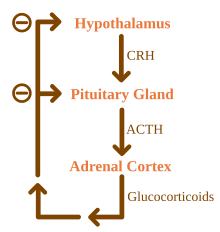Adrenal gland
The glucocorticoids cortisol and cortisone are synthesized in the zona fasciculata; their functions include the regulation of metabolism and immune system suppression.The innermost layer of the cortex, the zona reticularis, produces androgens that are converted to fully functional sex hormones in the gonads and other target organs.[4] The production of steroid hormones is called steroidogenesis, and involves a number of reactions and processes that take place in cortical cells.Cells in this layer form oval groups, separated by thin strands of connective tissue from the fibrous capsule of the gland and carry wide capillaries.[19] The adrenal medulla is driven by the sympathetic nervous system via preganglionic fibers originating in the thoracic spinal cord, from vertebrae T5–T11.[20] Unlike other sympathetic ganglia, however, the adrenal medulla lacks distinct synapses and releases its secretions directly into the blood.Its structure is different from the other veins in that the smooth muscle in its tunica media (the middle layer of the vessel) is arranged in conspicuous, longitudinally oriented bundles.[24] The adrenal gland produces aldosterone, a mineralocorticoid, which is important in the regulation of salt ("mineral") balance and blood volume.In the kidneys, aldosterone acts on the distal convoluted tubules and the collecting ducts by increasing the reabsorption of sodium and the excretion of both potassium and hydrogen ions.[29] The initial part of conversion of cholesterol into steroid hormones involves a number of enzymes of the cytochrome P450 family that are located in the inner membrane of mitochondria.Transport of cholesterol from the outer to the inner membrane is facilitated by steroidogenic acute regulatory protein and is the rate-limiting step of steroid synthesis.For example, the most common form of congenital adrenal hyperplasia develops as a result of deficiency of 21-hydroxylase, an enzyme involved in an intermediate step of cortisol production.The HPA axis is an example of a negative feedback system, in which cortisol itself acts as a direct inhibitor of both CRH and ACTH synthesis.The HPA axis also interacts with the immune system through increased secretion of ACTH at the presence of certain molecules of the inflammatory response.[31] Cells in zona reticularis of the adrenal glands produce male sex hormones, or androgens, the most important of which is DHEA.Adrenaline and noradrenaline act by interacting with adrenoreceptors throughout the body, with effects that include an increase in blood pressure and heart rate.Glucocorticoids produced in the adrenal cortex stimulate the synthesis of catecholamines by increasing the levels of tyrosine hydroxylase and PNMT.In the center is the adrenal medulla, which produces adrenaline and noradrenaline and releases them into the bloodstream, as part of the sympathetic nervous system.It first appears 33 days after fertilisation, shows steroid hormone production capabilities by the eighth week and undergoes rapid growth during the first trimester of pregnancy.The fetal zone produces large amounts of adrenal androgens (male sex hormones) that are used by the placenta for estrogen biosynthesis.More recent research suggests that BMP-4 secreted in adrenal tissue is the main responsible for this, and that glucocorticoids only play a role in the subsequent development of the cells.[45] The normal function of the adrenal gland may be impaired by conditions such as infections, tumors, genetic disorders and autoimmune diseases, or as a side effect of medical therapy.It can be the result of a prolonged treatment with glucocorticoids or be caused by an underlying disease which produces alterations in the HPA axis or the production of cortisol.The disease produces a wide variety of signs and symptoms which include obesity, diabetes, increased blood pressure, excessive body hair (hirsutism), osteoporosis, depression, and most distinctively, stretch marks in the skin, caused by its progressive thinning.In the Western world, Addison's disease is most commonly an autoimmune condition, in which the body produces antibodies against cells of the adrenal cortex.Apart from suppression of the axis by glucocorticoid therapy, the most common cause of secondary adrenal insufficiency are tumors that affect the production of adrenocorticotropic hormone (ACTH) by the pituitary gland.In the HPA axis, cortisol (a glucocorticoid) inhibits the release of CRH and ACTH, hormones that in turn stimulate corticosteroid synthesis.[52] One of the most recognized works on the adrenal glands came in 1855 with the publication of On the Constitutional and Local Effects of Disease of the Suprarenal Capsule, by the English physician Thomas Addison.[55] In 1894, English physiologists George Oliver and Edward Schafer studied the action of adrenal extracts and observed their pressor effects.[51] Edward Calvin Kendall, Philip Hench and Tadeusz Reichstein were then awarded the 1950 Nobel Prize in Physiology or Medicine for their discoveries on the structure and effects of the adrenal hormones.






PrecursorMesodermneural crestSystemEndocrine systemArterySuperiormiddleinferior suprarenal arteriesSuprarenal veinsCeliacrenal plexusLumbar lymph nodesAnatomical terminologyendocrine glandsadrenalinealdosteronecortisolkidneyscortexsteroid hormonesmedullaadrenal cortexzona glomerulosazona fasciculatazona reticularismineralocorticoidsglucocorticoidsandrogenselectrolyte balancecortisonemetabolismimmune systemgonadscatecholaminesrapid responsestressendocrine diseasesCushing's syndromeAddison's diseaseCongenital adrenal hyperplasiatumorsmedical imagingretroperitoneumfatty capsulerenal fasciaseptumconnective tissuediaphragmcrura of the diaphragmunder the microscopeviewed under a microscopehormonesthin strandscapillariesmineralocorticoidaldosterone synthaseregulation of blood pressuremitochondriadehydroepiandrosteroneDHEA sulfateandrostenedionetestosteronelipofuscinAdrenal medullachromaffin cellssympathetic nervous systempreganglionic fibersthoracic spinal cordpreganglionic nerve fiberssympathetic ganglionsmall arteriessuperior suprarenal arteryinferior phrenic arterymiddle suprarenal arteryabdominal aortainferior suprarenal arteryrenal arteryVenous bloodright suprarenal veininferior vena cavaleft suprarenal veinrenal veininferior phrenic veinsmooth muscletunica mediacongenital abnormalitiesenzymesCorticosteroidsblood volumedistal convoluted tubulescollecting ductssodiumglomerular filtrateAngiotensin IIpotassiumblood pressureglucocorticoidcorticosteroneglucoseamino acidssynthesis of glucosefree fatty acidsanti-inflammatoryosteoblastsgastrointestinal tractadrenocorticotropic hormoneanterior pituitarycircadian rhythm11β-HSDcorticosteroidcholesterolcholesterol esterslow density lipoproteinsreceptor-mediated endocytosisendoplasmic reticulumlysosomecytochrome P450steroidogenic acute regulatory proteinpregnenoloneP450sccmicrosomalhydroxysteroid dehydrogenases21-hydroxylaseHPA axishypothalamic–pituitary–adrenal axis (HPA) axis